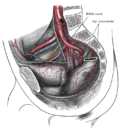| Common iliac artery | |
|---|---|
 Front of abdomen, showing surface markings for arteries and inguinal canal. | |
 Volume rendered CT scan of abdominal and pelvic blood vessels. | |
| Details | |
| Source | Abdominal aorta |
| Branches | External iliac internal iliac |
| Vein | Common iliac veins |
| Identifiers | |
| Latin | arteria iliaca communis |
| TA98 | A12.2.14.001 |
| TA2 | 4301 |
| FMA | 14764 |
| Anatomical terminology | |
The common iliac artery is a large artery of the abdomen paired on each side. It originates from the aortic bifurcation at the level of the 4th lumbar vertebra. It ends in front of the sacroiliac joint, one on either side, and each bifurcates into the external and internal iliac arteries.



